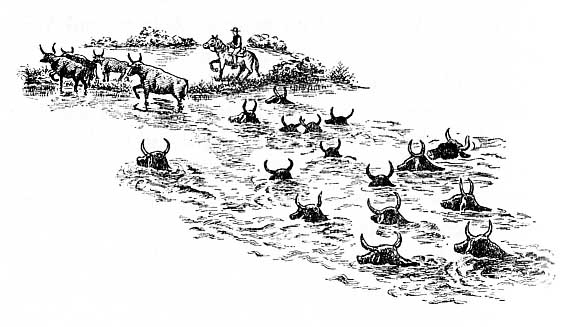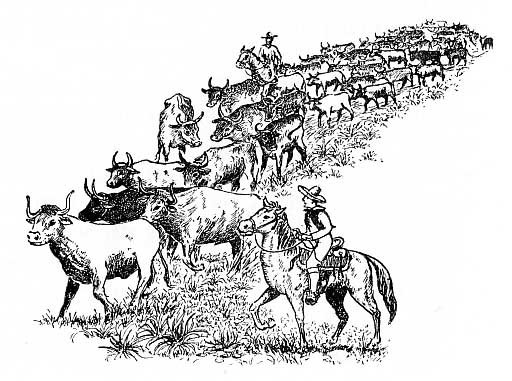
91
XVI – "Git Along, Little Dogies, Git Along!"
Not far from Santa Fe, New Mexico, the government had put a large group of Apache Indians under guard and was faced with the problem of feeding them. The best way to supply meat was on the hoof. A large commission house in Leavenworth was given a contract to deliver several thousand cattle. Jimmie Kerr, head of the firm, offered to pay me five dollars a day and all expenses if I would oversee a drive across the plains. Since "the long trail" was still in my blood, I accepted the job.
Among the twenty drivers I chose to help were Jim Dickson and my brother Jerome. Most of the men were recently discharged soldiers like myself. They were mounted on Indian ponies, while a special assistant and I rode mules. There were also two teamsters, each with a wagon drawn by three yoke of oxen. We started from Leavenworth with three hundred cattle, all branded with the letter K.
We picked up more at Auburn and Winchester, bringing the total to 1,233 animals.
Our orders were to let owners of the toll bridge at Lawrence supervise the crossing of the Kaw. Their plan was to have just fifteen or twenty cattle on the bridge at one time, so that it would not collapse. Bridges were something of a novelty in Kansas; and the animals, after starting across, would run back again in alarm.
For an hour or more the exhausted herders worked in vain, the animals becoming restive and unmanageable.92
Finally, a group got well out on the bridge and started to run forward. It was impossible to hold the others back. They all followed in a stampede, carrying the four bridge-owners, who were on horseback, along with them. The bridge trembled with the weight and everyone expected it to go down. Fortunately, the timbers held, enabling men and cattle to get across safely. Thoroughly frightened, the animals continued running down Massachusetts Street, and reached the banks of the Wakarusa before the drivers gained control.
Swollen streams, caused by heavy rains, were often almost impassable. We sometimes waited days for waters to subside before fording. Deep mud was also treacherous.
At various points along the Santa Fe Trail soldiers were stationed to provide escort from one fort or ranch to another. At Larned I was delighted to find my old Army commander, Colonel Cloud; but from that point on, just when we most needed it, there was no government protection.

93
We took the cutoff to Fort Dodge and were nearing Rio Blanco on a foggy night, when one of my men reported seeing horsemen on a ridge. The boys got their arms and ammunition and lined up ready for action. I rode back a hundred yards and met the Indians coming on the run. When they caught sight of the line of men, they veered off to one side and disappeared without firing a shot. A Mexican train, following some distance behind, did not fare so well. The Indians attacked and killed seven men. It had been a close call for us.
During the drive, night herders often sang plaintive cowboy songs to quiet the cattle; and even during the day, singing lightened the monotony of the road.
Throughout our journey, we passed large bearded buffalo by the tens of thousands, sometimes so near we had to drive them away from the cattle. Our closely bunched herds crept along the parched desert waste of Horn Alley, until we neared the Cimarron River. Then in a wild stampede for water, they scattered over thousands of acres. After several days spent in rounding them up for the remaining stretch, we felt our initiation into the brotherhood of cowpunchers was complete.
Government officials at Fort Union received, weighed, and counted the cattle. Having fulfilled our contract, we then prepared for the return trip.
The drive back was made later than usual. All but two of the ponies we left at Fort Union, the men now walking instead. We kept the two wagons, however, to haul grub and blankets. The route we chose this time was the Aubrey Trail, named for Felix X. Aubrey, a noted French-Canadian guide and the first man to take a loaded wagon train from the Missouri River to New Mexico94
in the winter. The greatest distance without water was only thirty miles, compared with the sixty miles along Horn Alley on the Cimarron River.
Captain Aubrey is best remembered for his famous ride from September 12 to 17, 1848, when he covered the distance from Santa Fe to Westport, Missouri, in five days and thirteen hours, stopping neither to eat nor sleep. He used eleven different horses and tied himself to the saddle so that he could doze without falling off. This astonishing feat, which won him a five-thousand-dollar wager, has never been equaled on the American continent.
Our men, in crossing the Arkansas River, nearly a mile wide, had to wade through slush and ice all the way. Snow on the farther bank was four inches deep. The few dry buffalo chips we had saved provided our only fuel for warmth and cooking. Sleepers crowded close together in the wagons, bundled in blankets against the chill of the plains.

95
James Dickson suddenly became quite ill and we were all deeply concerned. One of our drivers from Leavenworth had some training and experience as a doctor.
"There's only one possible chance of saving him," he declared, after an examination. "That's with quicksilver."
He said that the remedy itself might prove fatal, but Jim agreed to try it. After hours of anxious waiting there were signs of improvement. A feeling of relief swept over the camp. By the time we reached Auburn, where he turned in at his own gate to be greeted by his family, Jim was quite himself again. I had the feeling that our prayers, rather than quicksilver, had saved him.